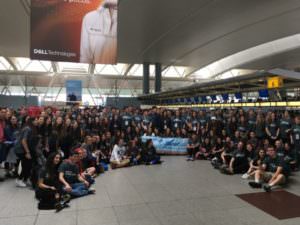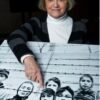
I had the privilege to be a part of BBYO’s recent March of the Living delegation. In addition to this, I was also given the opportunity to be the song leader for our group- I led all Shabbat and Havdallah services as well as provided meaningful spiritual moments throughout the trip to bring the group closer together, specifically in places that were hard for people to be alone. To give you a brief overview before I dive into the details, the trip went like this: one week in Poland visiting concentration camps, ghettos, and old Jewish villages, culminating in the actual “march” on Yom HaShoah from Auschwitz to Birkenau. Then, a red-eye to Israel followed by touring places like Tzfat, Tiberias, Tel Aviv and Jerusalem, and that part culminating in another “march”, this time from the city center in Jerusalem to the Kotel.

BBYO Delegation for MOTL
It’s difficult to think of my trip as a whole, easier to think of it as a collection of moments and experiences. We seldom remember entire experiences, and instead the small meaningful moments that they’re made from. So, I’ve decided to share the moments that were the most meaningful to me in hopes that they’ll mean something to you, too.
The first day in Kraków, we spent nearly 10 hours touring the remnants of what used to be the largest Jewish city in Poland. The town is misleading, almost an illusion. Despite all the signs on stores and restaurants being in Hebrew, there is not one Jew that lives in that town anymore. After walking in and out of larger-than-life synagogues, which, by the way, are NEVER filled with people anymore, we returned to the hotel. And after seeing what we saw that day, I felt the obligation to offer an optional Ma’ariv service for anyone in our delegation that wanted to attend. At nearly 11:30 p.m., almost 30 people stayed for Ma’ariv. As I finished davening with the Mourner’s Kaddish, a dear friend of mine turned to me and simply said, “Thank you for this.”

Brianah Caplan and David Hoffman – BBYO Head Songleaders for MOTL
The weather in Poland pretty much lined up with what we were seeing and feeling. It rained in every single camp we went to, and it even snowed at some. We first went to visit Auschwitz, which nowadays, is arranged like a museum. The blocks have been turned into exhibits, showcasing mass amounts of shoes, hairbrushes, pots and pans, tallitot, and other items people thought they would be allowed to keep upon the “resettlement”, which we all know now was a very loose term to describe what actually happened. We walked through the exhibits in silence, save for the brief explanations of what things were from our tour guide. All of a sudden, I heard the piercing sound of a baby crying. I turned, and behind me was a woman – not part of our group – and her baby boy. She quickly rushed him outside as to not disturb anyone else in the block we were in. In that moment, I realized that this place, at conception, was not as silent as it was now. I tried imagining what this place must have looked and felt like when there actually were cries like that. Not just one baby, hundreds. And not just babies, but women and children too as they were ripped away from their husbands and brothers. I tried to imagine it, and it felt almost impossible, so I kept walking and stayed silent for the remainder of the tour.
We then went to Birkenau, also known as “Auschwitz II.” Here is the infamous entrance, the train tracks going underneath the large brick tower and continuing on all the way through the camp. While Auschwitz was a working camp, Birkenau was a death camp. It doesn’t even deserve to be called a camp. Birkenau was, in the simplest terms, a death factory. We walked up along the train tracks to the entrance, and I felt a lump in my throat. This was the place I had seen so many pictures of and read about in so many books. As we walked closer, I realized the sheer enormity of this place. I walked hand in hand with Paul Galan, the survivor on our trip. This was his fourth time here, but only his third time with March of the Living. A lot of Birkenau is still there, but a lot of it also isn’t – specifically the gas chambers, which the Germans destroyed upon liberation. What’s left is empty barracks. Barracks which were built using the same blueprints used to build horse stables. Beds were built three bunks high, and we were told there could have been up to 5 or 6 people per bunk. No mattress, no pillows, no blankets. It was hard for me to believe this was a place where human beings were kept. The hardest part was that I knew it was true.
The next day, we returned back to Auschwitz for the march. I walked off the bus into a sea of people, all in the same royal blue “March of the Living” windbreakers. We marched together, every delegation; over 30 countries were represented.

March from Auschwitz to Birkenau
After a seven-hour drive from Krakow to Lublin, we went to Majdanek. Majdanek is different from the other camps we saw for two very specific reasons, and two reasons which bothered me very much. The first one being that Majdanek looks today exactly as it did when it was liberated in July of 1944. Every building there is one that was there during the war. Every barrack, gas chamber, and crematorium. With only a couple tools and a good electrician, Majdanek could be up and running again within 24-hours. The second reason that set Majdanek aside from the other camps was its location. Majdanek is a state park set in the center of Lublin. Some people’s houses share a fence of barbed wire with Majdanek. They literally live next to the camp. Also, being a state park, it’s a government owned property which is open to the public. Surrounding the camp is a path which locals use to walk their dogs, go jogging and ride their bikes. As we entered Majdanek, I saw a young gentleman walking his big black lab on this path. I hesitated at first, but eventually approached him. I asked him if he knew what happened here. He looked at me, saw I was wearing a kippah, and said calmly, “Yes.” I asked him if it bothered him, and if it did, why he walked his dog here. He knew why I was upset, but answered honestly. “This is the closest trail to where I live. And I hate to say this to you, but those of us who live here can’t let our country’s history hold us down forever. It’s horrible that those things happened here, but we have to keep living for those who couldn’t.” It was then that I realized the difference between “moving on” and “moving forward.” While we’ll never move on from what happened in these places, we have to move forward. We have to live our lives. Not in fear, not in the shadow of what happened to our people, and certainly not in sadness.
The last camp we visited was Treblinka. Treblinka was essentially the opposite of Majdanek. Not only was it in a forest in the middle of nowhere, but there’s absolutely nothing left of what Treblinka used to be. The camp wasn’t very big either as there weren’t any barracks. Treblinka consisted of gas chambers and crematoria only. You can probably guess what the routine there was. Today, in place of the camp itself, is a memorial. Probably the single most powerful memorial I have ever seen. For every village where people were taken from, there was a stone with the village’s name on it in the ground. The size of the stone correlated with the population of the village. And in the memorial itself, there were over 15,000 stones. Of all different shapes and sizes. I stood in shock. The amount overwhelmed me, and then I remembered that for every stone I saw, hundreds or even thousands of people lived in those villages. I tried to imagine what it would be like to see that many people all at once. I couldn’t do it. As I walked out toward the buses, I turned around and looked behind me. I realized how lucky I was to walk out of this place. Nobody, nobody, nobody ever walked out of this place.
We took a silent bus ride to the airport in Warsaw, each one of use digesting what we had seen in the previous week. After a few hours, I decided that where we were about to travel to next deserved some excitement and build-up. I plugged my phone into the sound system on the bus, and blasted (seriously, full volume) Matisyahu’s “Jerusalem.” The faces of almost every single person on the bus lit up. They started singing along, dancing in the aisles. I could tell that it hit them: We were going to Israel.
We landed at around five in the morning to Tel Aviv and immediately drove to the beach at Caesarea. All 168 of us gathered in a circle in the sand as I led them in Hatikvah and Shehechiyanu, followed by Hannah Sesesh’s “Eli, Eli”. I have been to Israel before, but this time felt different. Much different.

March in Israel from City Center to Kotel
We did your typical Birthright-esque Israel trip, mostly for the teens in the delegation who had never been, which was over half. We had an incredible time, but one moment in particular has stuck with me from our time in Israel: Shabbat.
The contrast in energy between Shabbat in Kraków and Shabbat in the Kineret was almost tangible. We had just visited Tzfat that day, the hometown of Kabbalah, so I was compelled to lead a full, Carlebach, Kabbalat Shabbat. Every. Single. Psalm.
I was hesitant at first. Teens are almost infamous for their short attention spans, especially if you have them do something directly preceding a meal. But I went for it. And I was shocked. In a room with less than 200 people in it, it felt like we were in a sea of thousands. We sang and celebrated together during Kabbalat Shabbat for almost two hours.
Your typical concluding prayer for Friday Night Ma’ariv is Yigdal. I looked at the liturgy and wasn’t particularly moved by it, so I went with something else. The words to our concluding prayer were as follows: Ivdu Et Hashem B’Simcha, Bo Lefanav Birnana. Serve Hashem with happiness. Come before God’s presence with joy.

Closing song on top of Masada
The Hebrew word avodah means work, but it can also mean service. It is not enough to be a witness. We were told that that was the most important thing. To witness. But I’d like to ask that we go further. I’d like to ask that we take what we learn, whether it’s physically in the place where it happened or not, and put it to work. I had the opportunity to participate in the March of the Living with survivors. But soon enough, there won’t be survivors to tell us their stories first hand. So then it will be on us, and we will be responsible. Then, we will have to stop only witnessing, and start working. Ivdu Et Hashem. “Never Again” is only a phrase until we put it into action. We will continue to tell the stories and service our communities on their behalf. And when we are serving our community, we are, in turn, serving God. Ivdu Et Hashem.
Originally published HERE






